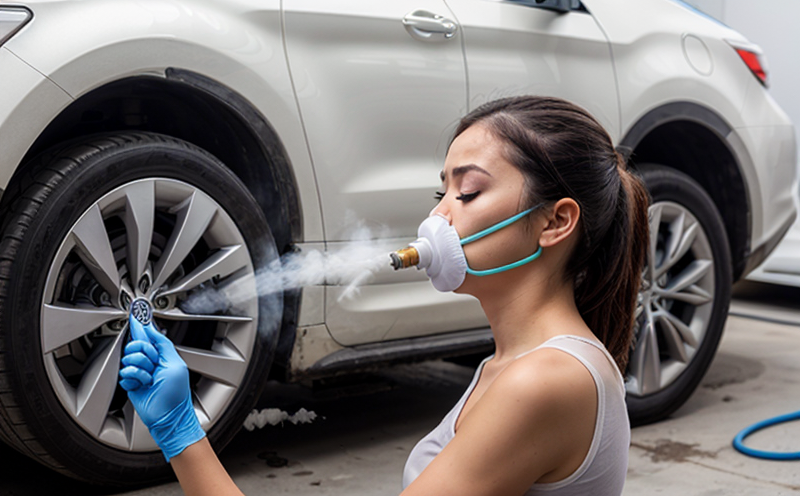GB T 17792 Heavy Metal Emission Testing in Paints
The GB/T 17792 standard is a Chinese national standard that specifies methods for determining heavy metal emissions from paints. This testing service ensures compliance with environmental regulations and helps manufacturers to produce safer, more sustainable products. The test covers various heavy metals such as lead (Pb), cadmium (Cd), chromium (Cr), mercury (Hg), and others, which are known to have adverse health effects when present in paint.
The testing process involves several key steps: sampling the paint specimen, preparing it for analysis, conducting emission tests under controlled conditions, and finally analyzing the results. The emitted heavy metals are typically quantified through atomic absorption spectroscopy (AAS) or inductively coupled plasma mass spectrometry (ICP-MS). These methods provide precise measurements of the concentrations present in the paint.
The importance of this testing cannot be overstated, especially for industries that use paints heavily. This includes automotive manufacturing, construction, and consumer goods sectors where exposure to heavy metals can have serious health implications. Compliance with GB/T 17792 helps manufacturers avoid penalties and maintain a positive reputation among consumers who value environmental responsibility.
For R&D engineers working on new paint formulations, this testing is crucial for ensuring that their innovations meet both regulatory requirements and market expectations. It also allows them to identify potential issues early in the development process, saving time and resources. Compliance officers can use these test results as part of their broader compliance strategy, helping to ensure that all products comply with relevant standards.
Quality managers rely on such testing to maintain consistent product quality across batches. By regularly monitoring for heavy metal emissions, they can catch any deviations from expected levels early, allowing for corrective actions before the products reach consumers or are sold commercially.
The test results not only inform compliance but also contribute to improving product safety and environmental impact. Companies that demonstrate a commitment to reducing harmful substances in their products are likely to attract more environmentally conscious customers. This can lead to increased market share and customer loyalty, which are critical factors for business success.
Understanding the standards and methods involved is essential for anyone involved in the paint industry or related sectors. Familiarity with GB/T 17792 allows stakeholders to make informed decisions about product development, production processes, and quality control measures. This knowledge also enables better communication between different teams within an organization—such as R&D, manufacturing, and compliance—who all play important roles in ensuring that products meet regulatory requirements.
Given the complexity of modern paint formulations and their potential impact on human health and the environment, it is vital for companies to stay updated with current testing practices. Regular audits against standards like GB/T 17792 can help identify areas for improvement and ensure continuous compliance with evolving regulations.
Benefits
- Regulatory Compliance: Ensures that products meet national and international regulations, thereby avoiding legal penalties.
- Enhanced Product Safety: Identifies and mitigates risks associated with harmful substances in paints.
- Increased Customer Trust: Demonstrates a commitment to environmental responsibility, which is increasingly important for consumer goods companies.
- Improved Reputation: Positive reputation among consumers who value eco-friendly products can lead to higher market share and customer loyalty.
Customer Impact and Satisfaction
The results of GB/T 17792 heavy metal emission testing directly impact customers by ensuring the safety and quality of the paints they use. For businesses, it means better product reliability and reduced risk of recalls or lawsuits due to non-compliance with regulations. Consumers benefit from knowing that the products they purchase are safe for use in their homes or workplaces without contributing to environmental pollution.
By adhering to these tests, companies can build trust within their customer base, fostering long-term relationships based on reliability and quality assurance. This trust is particularly valuable in sectors where product safety is paramount, such as healthcare, construction, and automotive manufacturing.
The process of GB/T 17792 testing also provides valuable insights into how different ingredients interact during the paint production process. These insights can be used to develop safer formulations that still deliver excellent performance characteristics like durability and colorfastness.
Environmental and Sustainability Contributions
- Promotes Sustainable Practices: By reducing or eliminating harmful substances from paints, this testing helps promote more sustainable manufacturing practices.
- Reduces Environmental Impact: Lower emissions of heavy metals contribute to cleaner air quality and reduced pollution levels.
The reduction in heavy metal emissions not only benefits the immediate environment but also supports broader efforts towards global sustainability goals. Companies that engage in these types of testing are contributing positively to the fight against climate change and environmental degradation.
Moreover, by participating in such tests, businesses can help set industry-wide standards for safer products. This collaborative approach fosters innovation within the sector while promoting collective responsibility for protecting public health and the environment.





